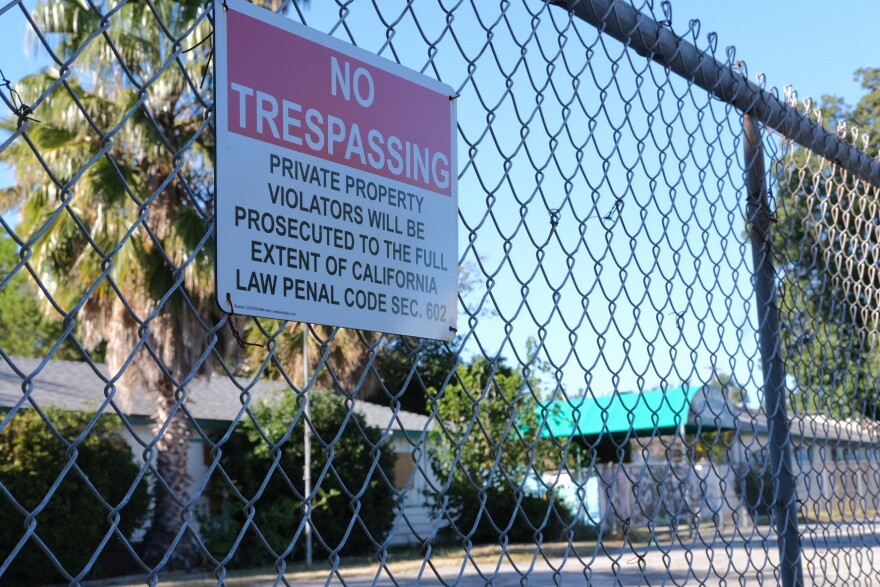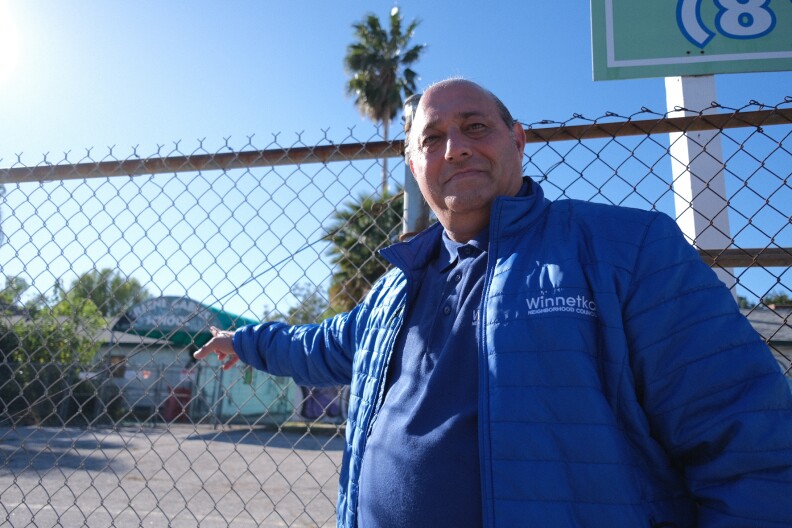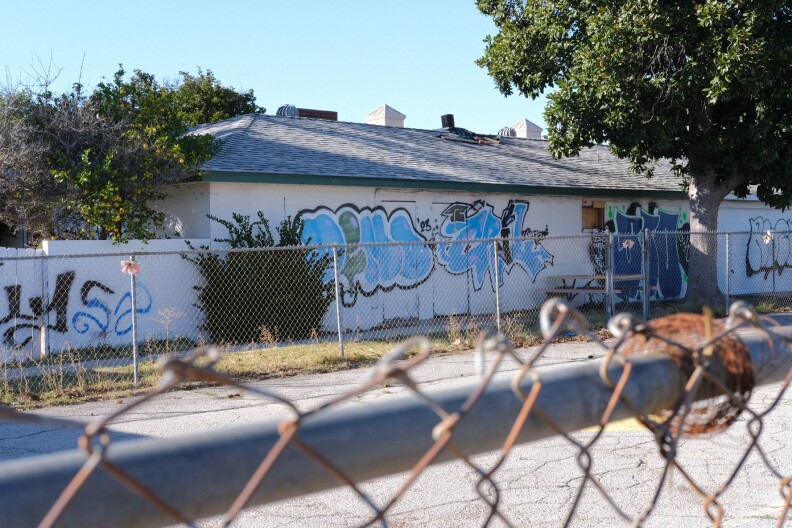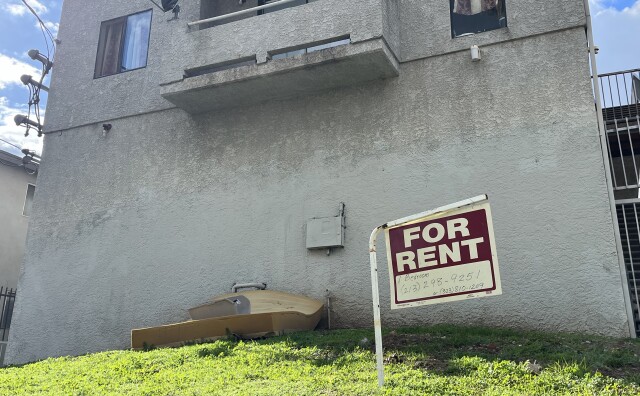LA Mayor Promised To Fast-Track Affordable Housing. But Plans Near Single-Family Homes Have Stalled

To cap off her first week in office last December, L.A. Mayor Karen Bass gathered reporters at a dusty patch of dirt in Boyle Heights. From a podium, she explained that construction of affordable housing on that site had taken 16 years to break ground.
Bass said she would no longer tolerate such delays. She was there to sign Executive Directive One (ED1), an order for city staff to approve applications for 100% affordable housing developments within 60 days, and to issue building permits within five days.
“Affordable housing projects are only being built in certain locations and not others,” Bass said at the news conference. “This is at a time when we need housing all across Los Angeles.”
Six months later, with less fanfare, Bass updated the rules to say that projects in single-family neighborhoods would be ineligible.
Since that change in June, an LAist review found the city has placed nine affordable housing projects near single-family homes in limbo, creating an uncertain future for 1,443 potential units of low-income housing.
“[Developers] were hoping and relying and expecting on the benefit of ED1 — and then the rules changed,” said land use attorney Dave Rand, who is now representing a number of developers trying to appeal the city’s ED1 denials.
“The end result will be a lot of lost housing units that could have been built in these areas,” Rand added. “Some people may celebrate that and think that's a fantastic thing. I think it's the loss of a good number of much-needed affordable homes.”
L.A. needs more affordable housing, fast
The minutiae behind the processing of applications for development projects may sound tedious, but the stakes are high for Angelenos increasingly struggling to pay their rent.
Between 2010 and 2019, as rents climbed, L.A. lost about 111,000 homes considered affordable to low-income families by government standards. At the same time, the city only built about 13,000 new affordable homes. Plus, affordable housing covenants that restricted rents on buildings constructed in the 1980s and 90s have been expiring, in some cases leading to mass evictions.

ED1 was designed to confront these problems by getting new affordable housing projects ready to break ground faster than any other time in L.A.’s recent history.
Bass’s directive has found success outside of single-family neighborhoods. L.A. planning officials told LAist the department has already approved applications for 59 projects representing more than 4,620 new affordable apartments.
But Rand said city officials should expand on that success by processing applications based on the rules in place when they were filed. By retroactively changing the rules, he said, L.A. could lose many desperately needed low-income homes.
“It could be the difference between deciding to do the project or not at all,” Rand said.
Some developers have withdrawn their applications, acknowledging that their projects no longer make financial sense without ED1 fast-tracking. Others may decide to re-file their applications, but this time including more expensive market-rate apartments.
California officials weigh in
State housing officials have sided with the developers. California Department of Housing and Community Development officials have sent letters urging the city to quote “apply the law consistently.”
Applicants who submitted paperwork “may proceed under the ED1 regulations that were in effect at the time the preliminary application was complete,” wrote Shannan West with the state’s Housing Accountability Unit in October.
A mayor’s office spokesperson told LAist in an email that ED1 has accelerated thousands of units of affordable housing.
“The city has seen an 85% increase in the number of affordable housing units proposed,” said Bass press secretary Clara Karger.
While not eligible for ED1, projects near single-family homes can still go through the normal approval process, Karger said. That process can involve years of environmental review and contentious public hearings with L.A.’s Planning Commission.
“The mayor believes that any policy implemented should be evaluated to ensure there are no unintended consequences on communities, especially the very ones we are trying to help,” Karger said.
The mayor’s office did not agree to requests to interview Bass directly.

The politics of building in single-family zones
If the city doesn’t reverse course, pro-housing activists say they’ll sue. Sonja Trauss with YIMBY Law, a group that takes legal action against cities it believes are flouting state housing law, told LAist that her organization plans to file a lawsuit soon.
“It's not the right way for the city to treat people who are creating affordable housing,” Trauss said. “Hopefully the mayor gets the message that backpedaling wasn't as politically necessary or beneficial as she thought.”
Most of L.A.’s residential land — 74% to be exact — is zoned for single-family homes. Building large apartment developments in those areas has long been seen as politically risky, because it tends to enrage homeowners opposed to neighborhood change.
UCLA urban planning professor Paavo Monkkonen said leaving suburban areas untouched brings its own risks. The city of L.A. has some big housing goals to meet under state law. The city must plan for 185,000 new low-income homes by 2029.
State law also requires the city to reverse long-standing patterns of segregation by putting many new affordable homes in wealthier areas, such as single-family neighborhoods.
“Once you take them off the table, it's really hard to live up to the fair housing mandate,” Monkkonen said.
In Winnetka, an uncertain future for a shuttered school
Without a guaranteed path forward, it’s unclear what’ll happen to project sites where plans for low-income apartments were already in the works.
Along a busy thoroughfare in the San Fernando Valley, cars going 40 mph zoom past a padlocked fence surrounding a boarded-up private school in Winnetka. Weeds poke through the cracked asphalt outside a building covered in graffiti.
A developer wants to turn this site into 360 low-income apartments. Standing outside the defunct elementary school, Winnetka Neighborhood Council president Mihran Kalaydjian said the community is against it.
“It needs to be away from residential,” he said, explaining that he believes affordable housing developments shouldn’t create difficulties for local businesses, shouldn’t affect homeowners’ property values, and shouldn’t be located near schools.

The site is across the street from a public elementary school. It’s also next to a gas station and across the street from a Mercedes-Benz service center. But Kalaydjian said the single family homes down the street make this the wrong place to build.
“There are many other locations they need to take into consideration,” he said.
The area’s councilmember, Bob Blumenfield, is also against fast-tracking this project and others in his district.
“ED1 basically removes the community input from the process,” Blumenfield said in an interview.
That kind of streamlining is acceptable in parts of the city that already have large apartment buildings, he said. But in low-density areas, “removing the public input is not appropriate at this point.”
The view from South L.A.
Tenant advocates say that by cutting single-family neighborhoods out of ED1, the Bass administration has increased development pressure on poorer parts of the city.
“The majority of the affordable housing is happening in South L.A. or in areas that are not high resource,” said Maria Patiño Gutierrez with Strategic Actions for a Just Economy.
In some cases, Gutierrez said working class tenants are seeing their old, rent-controlled buildings demolished to make way for development of new ED1 projects.
Under state law, low-income renters have a right to move into new affordable housing built in place of their demolished homes. But Gutierrez said tenants often find the process confusing and unmanageable.
“Though there are state protections and local laws, we don't think that all the community members know they have the right to return,” Gutierrez said.

When housing fights in single-family neighborhoods get ugly
City councilmember Nithya Raman believes L.A. should keep ED1 projects proposed near single-family homes in the fast lane. She has voted to advance an ED1 project in her district, and has cast lone votes supporting projects in other districts.
“We should be following the law,” Raman said in an interview. “We should be pushing towards a system where many more of our planning decisions are not discretionary votes that are coming in front of an individual council office, or to the council at all.”
Raman and her staff have faced harsh pushback from some constituents over her support of an ED1 project aiming to build 200 units of affordable housing in a seven-story structure on Ethel Avenue in Sherman Oaks.
A number of Raman’s district staff, including two who identify as Muslim, attended the Sherman Oaks Street Fair in October. They say protesters opposed to the Ethel project surrounded their booth, waved signs and distributed flyers about saving single-family neighborhoods, and called Raman and her staffers “terrorists.”
A video taken that day shows the protesters following staffers while they packed up to leave the street fair. At first, the protesters tell the staffers they never used the word “terrorist.” Then, one of them says, “Well, if you’re inflicting terror on us, then I guess you’re terrorists.”
Raman condemned the use of the word “terrorist” by protesters.
At the same time, Raman said she also understands concerns about large developments coming to residential areas. If it were up to her to design affordable housing projects for the area, she said, she wouldn’t make them seven stories tall.
But saying no to developers who complied with the city’s guidelines could scare others away from proposing more affordable housing, Raman said.
“If we create a system where, even if you follow the rules, your project will not move forward, I think we make it much harder for us to generate the kind of construction that we do need,” Raman said. “That's an existential threat for the city.”
-
The city passed a law against harassing renters in 2021. But tenant advocates say enforcement has been lacking.
-
The Emergency Rental Assistance Program will provide up to three months of support to families with unpaid rent or at risk of becoming unhoused.
-
Now that L.A. officials know who landlords are trying to evict, city workers are showing up at renters’ doorsteps to offer help.
-
Allowable rent hikes depend on where you live, and in what type of building. Here’s your guide to figuring it all out.
-
The council approved a hotly debated proposal to lower allowable rent hikes in most of the city’s apartments from a maximum of 9% to 6% in February.
-
The vibrant neighborhood crams 700 restaurants into a roughly two-mile radius, while many workers cram themselves into overcrowded apartments.







